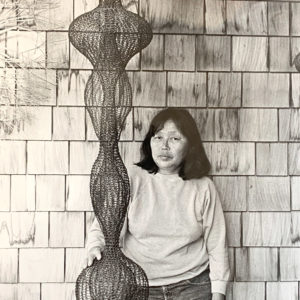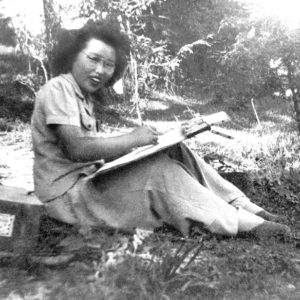calsfoundation@cals.org
Ruth Asawa (1926–2013)
Ruth Asawa, an internationally acclaimed artist and advocate for arts education, gained renown for her distinctive looped-wire sculptures and public commissions. A second-generation Japanese American, she was interned with her family during World War II at the Rohwer Relocation Center in Rohwer (Desha County). During her internment, she continued to practice and develop her art.
Ruth Aiko Asawa was born in Norwalk, California, on January 24, 1926. Her parents, Umakichi Asawa and Haru Asawa, were immigrants from Japan and worked in agriculture, driving produce trucks. She was the fourth of seven children, all of whom had various jobs and chores around the farm. Riding on the back of the farm leveler as a child, Asawa would make looping shapes in the dirt by dragging her feet. She would later say that these memories manifested in her biomorphic wire sculptures.
She showed an interest in art at an early age. Her third-grade art teacher nurtured her interest, and she won a school art competition. As part of the community’s Japanese cultural school, she also took calligraphy lessons.
In February 1942, Asawa’s father was arrested under Executive Order 9066, which authorized the incarceration of people of Japanese ancestry residing on the West Coast. Not long afterward, the rest of the Asawa family were forced to sell their belongings and take only what they could carry, first to a temporary camp at the Santa Anita racetrack in Arcadia, California, where they lived for about six months in two horse stalls, and next, to the Rohwer internment camp in Arkansas, where Asawa would live from September 1942 until her high school graduation in September 1943.
During her time at the Santa Anita racetrack, she received art lessons from Disney animators who were also being interned there. At Rohwer, she became the art editor for the high school yearbook. Later in life, she would reflect back on her internment: “I hold no hostilities for what happened; I blame no one. Sometimes good comes through adversity. I would not be who I am today had it not been for the internment, and I like who I am.”
Having won a scholarship to attend the Milwaukee State Teachers College in Wisconsin, Asawa studied to be an art teacher from 1943 to 1946. However, lingering post-war racism against Japanese people made it impossible for her to secure the teaching assignment she needed to graduate, and she was denied her bachelor’s degree and teaching certificate. After this, she left to study art at the experimental Black Mountain College in North Carolina. There, she would study under influential artists and architects such as Josef Albers and Buckminster Fuller, both of whom would continue to advise her throughout her career.
Asawa met her future husband, architect Albert Lanier, while studying at Black Mountain College. The interracial couple married in 1949, against the wishes of their parents, and moved to San Francisco, California, where they had six children together.
While raising her children, Asawa would wake up early and stay up late developing her artistic practice. Her early shows include exhibitions at the Whitney Museum of American Art and the Museum of Modern Art (MoMA) in New York City. In 1955, her art was shown in the São Paolo Art Biennial.
During the 1960s, Asawa shifted her focus to public art commissions and creating public programs in the arts. After producing several large-scale artworks—including her bronze mermaid fountain, Andrea, in San Francisco’s Ghirardelli Square—she was appointed to the San Francisco Arts Commission. Many of her publicly commissioned works are fountains in and around San Francisco. After serving for eight years on the San Francisco Arts Commission, she was appointed to President Jimmy Carter’s Role of the Arts Committee and the National Endowment for the Arts (NEA) task force on the training and education of artists, as well as the NEA’s Craft Planning Project.
Asawa’s belief in the transformative power of making art led her to become more involved with arts education, culminating with the founding of the San Francisco School of the Arts in 1982, which was officially renamed in her honor in 2010. The Crystal Bridges Museum of American Art in Bentonville (Benton County) has three Asawa works: two wire sculptures and one self-portrait done in ink on paper.
Asawa died on August 6, 2013, and was cremated. The U.S. Postal Service released stamps featuring her wire sculptures in August 2020.
For additional information:
“Buy Ruth Asawa Stamps from the US Postal Service.” Crystal Bridges Museum of American Art. https://crystalbridges.org/blog/buy-ruth-asawa-stamps-from-the-us-postal-service/ (accessed February 16, 2023).
Chase, Marilyn. Everything She Touched: The Life of Ruth Asawa. San Francisco, CA: Chronicle Books, 2020.
Luckel, Madeleine. “Ruth Asawa’s Life Was Even More Remarkable Than You Thought.” ArchitecturalDigest.com. https://www.architecturaldigest.com/story/ruth-asawas-life-was-even-more-remarkable-than-you-thought (accessed February 16, 2023).
Ruth Asawa. https://ruthasawa.com/ (accessed February 16, 2023).
Urbanelli, Elisa, and Daniel Cornell, eds. The Sculpture of Ruth Asawa: Contours in the Air. Berkeley: University of California Press, 2006.
Wakida, Patricia. “Ruth Asawa.” Densho Encyclopedia. http://encyclopedia.densho.org/Ruth_Asawa/ (accessed February 16, 2023).
Blair Hollender
West Fork Public Library
 Arts, Culture, and Entertainment
Arts, Culture, and Entertainment World War II through the Faubus Era, 1941 through 1967
World War II through the Faubus Era, 1941 through 1967 Ruth Asawa
Ruth Asawa  Ruth Asawa
Ruth Asawa 




Comments
No comments on this entry yet.